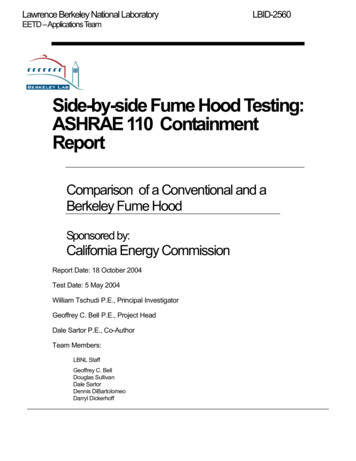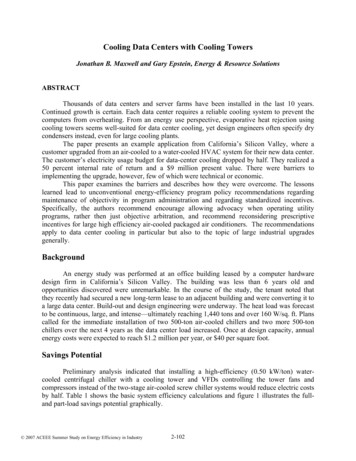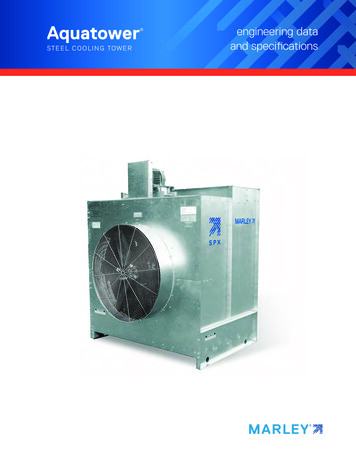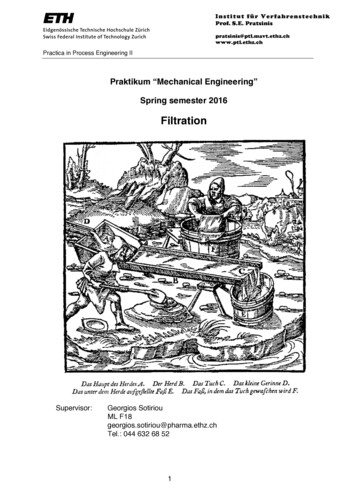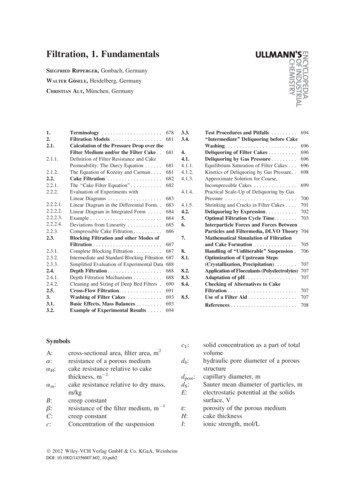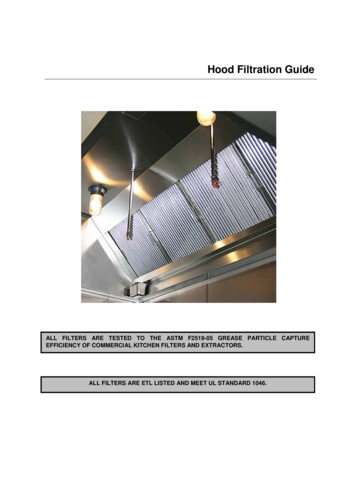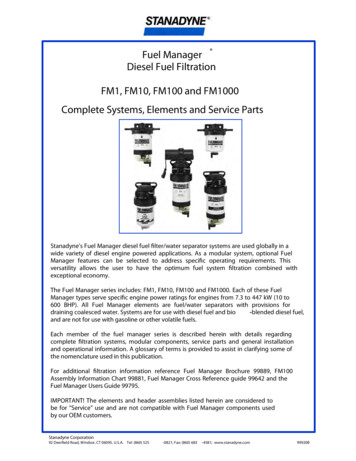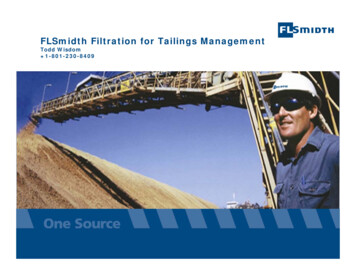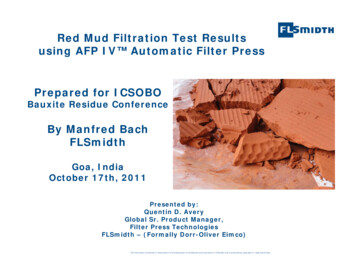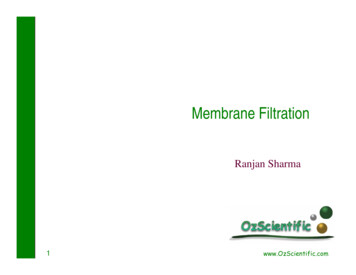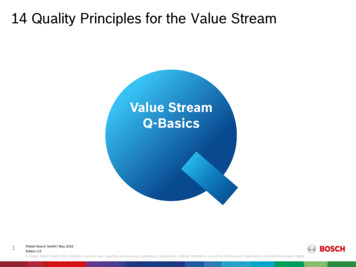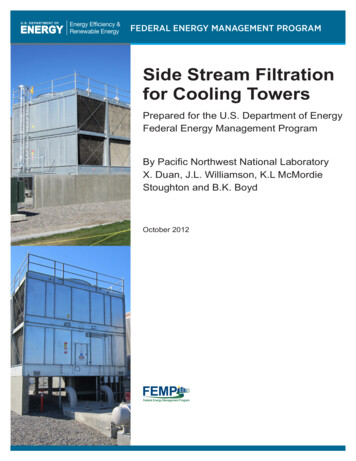
Transcription
FEDERAL ENERGY MANAGEMENT PROGRAMSide Stream Filtrationfor Cooling TowersPrepared for the U.S. Department of EnergyFederal Energy Management ProgramBy Pacific Northwest National LaboratoryX. Duan, J.L. Williamson, K.L McMordieStoughton and B.K. BoydOctober 2012
ContactWill Lintner, PEFederal Energy Management ProgramU.S. Department of Energy1000 Independence Ave. SWWashington, DC 20585-0121Phone: (202) 586-3120E-mail: william.lintner@ee.doe.govCover photo: Cooling Towers. Photo from Pacific Northwest National Laboratoryi
AcknowledgementsThe authors of the report would like to thank the following individuals that provided support tothe production of the technology evaluation:Elisabeth GieverRose ZandersJim CabeMatt WilburnShannon Colsonii
Abbreviations and AcronymsASHRAEAmerican Society of Heating, Refrigerating, and AirConditioning EngineersBLCCBuilding Life Cycle CostFEMPFederal Energy Management Programgpmgallons per minutekWkilowattkWhkilowatt hourLCClife-cycle costLlitermmmillimeterORNLOak Ridge National LaboratoryROIreturn on investmentSNSSpallation Neutron SourceTSStotal suspended solidiii
ContentsExecutive Summary . vii1Technology Review and Evaluation . 11.1 Background .11.2 Technology Characterization .31.3 Technology Applications .52Side Stream Filtration System Options . 72.1 Centrifugal Separators .72.2 Automatic Screen Filters.82.3 Plastic Disc Filters .92.4 Sand Filters .102.4.1 Pressure Sand Filters .112.4.2 High Efficiency Sand Filters .123System Economics . 134Evaluate Field Application of Technologies . 155System Implementation Considerations . 166References . 19iv
List of FiguresFigure 1.1. Cooling Tower Primary Treatment Concerns. . 2Figure 1.2. Cooling Tower with Side Stream Filtration Examples. 3Figure 2.1. Centrifugal Separator Schematic. . 8Figure 2.2. Automatic Screen Filter Schematic. . 9Figure 2.3. Plastic Disc Filters. . 10Figure 2.4. Pressure Sand Filter Schematic. . 11Figure 2.5. High Efficiency Sand Filter Schematic. . 12v
List of TablesTable ES.1 Side Stream Filtration System Characteristics . viiTable 1.1. Relative Size of Common Cooling Water Contaminants (McDonald 2009). . 4Table 2.1. Side Stream Filtration System Characteristics. . 7Table 3.1. Life-Cycle Analysis for Gravity Sand Filtration Systems.* . 14Table 4.1. ORNL Particle Distribution Analysis. . 15vi
Executive SummaryThis technology evaluation assesses side stream filtration options for cooling towers, with anobjective to assess key attributes that optimize energy and water savings along with providinginformation on specific technology and implementation options. This information can be used toassist Federal sites to determine which options may be most appropriate for their applications.This evaluation provides an overview of the characterization of side stream filtration technology,describes typical applications, and details specific types of filtration technology.Cooling towers are an integral component of many cooling systems that provide comfort orprocess cooling. Cooling tower systems operation is most efficient when their heat transfersurfaces are clean. However, due to variations in the water source and their operating in anopen environment, cooling towers are subject to four major water treatment concerns: corrosion,scaling, fouling and microbiological activity. These factors can significantly reduce theefficiency of the cooling towers. Side stream filtration systems can be a cost effective methodto address these water concerns through filtering suspended solids out of the cooling water.Side stream filtration systems continuously filter a portion of the cooling water to removesuspended solids, organics, and silt particles, reducing the likelihood of fouling and biologicalgrowth, which in turn helps to control other issues in the system such as scaling and corrosion.This results in both water and energy efficiency gains due to a reduction in the amount of waterdischarged from the cooling system and a decrease of scale formation on the heat transfersurfaces. The filter types examined in the technology evaluation are centrifugal separators,automatic screen filters, plastic disc filters, and sand filters. An overview of their maincharacteristics is summarized in Table ES.1 and more detailed information on each systemtype is presented in the main body of the report.Table ES.1. Side Stream Filtration System omaticScreenFilterParticle RemovalLevel40-75 microns, fine tocoarse inorganics with aspecific gravity (1.62) orgreaterDown to 10 micronsPlastic DiscFilterDown to 10 micronsSandFiltersDown to 10 microns forpressure sand filters;Down to 0.45 microns forhigh efficiency sand filtersBasic FilteringMechanismApplicationsNotesHigh velocity water is fed ina circular pattern thatmoves heavier particlesdown and out of the systemWater moves through arigid screen, where largeparticles are trapped andsucked out of the systemGrooved, stacked platestrap particles as watermoves through the discsBest for removal of large,heavy particlesMinimalmaintenance isrequiredBest for systems thatcannot be interruptedsuch as industrialprocesses and hospitalsAppropriate whereremoval of both solidsand organics are requiredLayers of granulated sand,trap particles as watermoves through the sandlayersBest for applications thatrequire the removal offine and low densityparticlesSelf cleaningmechanism allowsfor no interruptionin operationSelf cleaningmechanism isautomatic andrequires little downtime of the systemSupplementalchlorine may beneeded becausesand filters canpromote biologicalgrowthvii
A life-cycle cost analysis was performed on a hypothetical example of a pressure sand filter sidestream filtration system as part of the technology evaluation. The system characteristics werebased on a typical system for a 400 ton chiller with a total installation cost of 45,000 (seeSection 3 on System Economics for more details on the example system). The results of the lifecycle cost analysis shows an annual cost savings of 8,800, 8 year simple pay back, and asavings to investment ratio of 2.3.When considering a side stream filtration system, there are several key parameters that areimportant to weigh including the level of particle removal, filtration sizing, installation methods,economic analysis, and savings potential. Careful examination of these features will help toproperly specify the side stream filtration system for the appropriate application.viii
1 Technology Review and EvaluationThis technology evaluation was performed by Pacific Northwest National Laboratory on behalfof the Federal Energy Management Program (FEMP). The technology evaluation assesses sidestream filtration for cooling towers. The evaluation provides a characterization of side streamfiltration technology, describes typical applications, and details specific types of filtrationtechnology. System economics are also discussed, providing an example project with life-cyclecost analysis results to show the potential savings of a typical application. A Federal case studyat Oak Ridge National Laboratory (ORNL) is also provided to showcase a success story of a sidestream filtration application.The evaluation’s overall objective is to provide information on key impacts related to energy,water, and cost savings of side stream filtration as well as key attributes on specific technologyoptions and component specifications so that Federal energy and facility managers can makeinformed decisions on which options may be most appropriate for their site.1.1 BackgroundCooling towers are an integral component of many cooling systems that provide comfort orprocess cooling. They are commonly used in industrial applications and in large commercialbuildings to release waste heat extracted from a process or building system through evaporationof water. They receive the heated water, and evaporate a portion of the water to cool theremaining water so that it can re-used to again extract heat from the cooling system.Cooling tower systems operation is most efficient when their heat transfer surfaces are clean.However, these are dynamic systems, due to variations in the water source and their operating inthe open environment. Surface water sources such as lakes, rivers, and streams have seasonalvariations in water quality and can carry high levels of suspended silt and debris. Groundwatersources don’t have the seasonal variations, but can have high levels of dissolved mineralsdepending on the geology of the region.Since cooling towers operate outside they are susceptible to dirt and debris carried by the wind.Birds and insects like to live in and around cooling towers due to the warm, wet environment.The combination of process and environmental factors can contribute to four primary treatmentconcerns encountered in most open-recirculating cooling systems: corrosion, scaling, fouling,and microbiological activity. As shown in Figure 1.1, these treatment concerns are inter-relatedsuch that reducing one can have an impact on the severity of the other three. Corrosion: Corrosion is an electrochemical or chemical process that may lead to thepremature failure of system metallurgy. The process of corrosion can be intensified byelevated levels of dissolved mineral content in the water and the presence of oxygen, bothof which are typical of most cooling tower systems.1
Scaling: Scaling is the precipitation of dissolved mineral components that have becomesaturated in solution, which can lower efficiency of the system. Factors that contribute toscaling tendencies include water quality, pH, and temperature. Scale formation inhibitsheat exchangers because of the insulating properties of scale. Scale buildup will make theentire system work harder to meet the cooling demand. Fouling: Fouling occurs when suspended particles or biologic growth forms an insulatingfilm on heat transfer surfaces. Common foulants include organic matter, process oils,and silt, which can also lower system performance. Factors that cause fouling includecorrosion and process leaks. Much like scale, fouling deposits create an insulating barrieron the heat exchanger surfaces that can significantly affect the energy performance of thecooling system. Microbiological Activity: Microbiological activity refers to microorganisms that live andgrow in the cooling system that can contribute to fouling and corrosion. Cooling towersare a perfect environment for biological activity due to the warm, moist environment.There are two distinct categories of biological activity in a tower system: planktonic andsessile biogrowth. Planktonic is a bioactivity that is suspended or floating in solution.Sessile biogrowth is a bioactivity that sticks to surfaces, such as biofilms or biofouling.Biofilms are problematic for several reasons. They have strong insulating properties thatincrease energy requirements, they contribute to fouling and corrosion, and they createbyproducts that further increase microbiological activity. Sessile biogrowth can generallybe found in and around the tower structure, in chiller bundles, on heat exchange surfaces,and in the system piping. Biofilms and algae mats can also be difficult to eradicate.Figure 1.1. Cooling Tower Primary Treatment Concerns.Side stream filtration systems reduce suspended solids and debris in the system coolingwater, which leads to less fouling in
process cooling. Cooling tower systems operation is most efficient when their heat transfer surfaces are clean. However, due to variations in the water source and their operating in an open environment, cooling towers are subject to four major water treatment concerns: corrosion, scaling, fouling and microbiological activity. These factors can .
